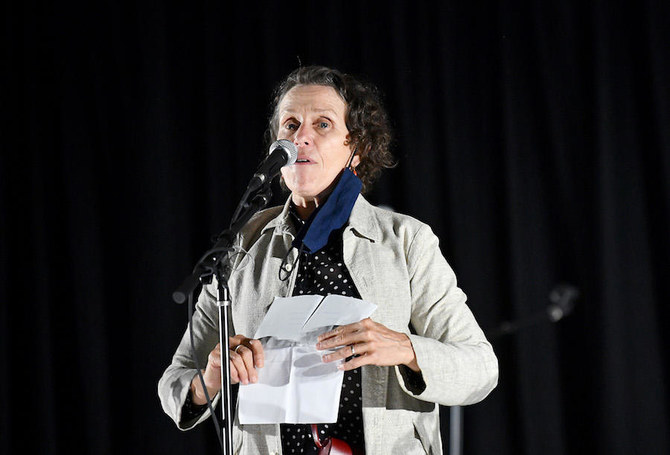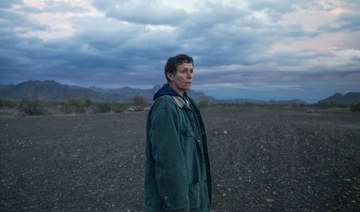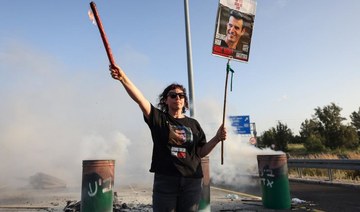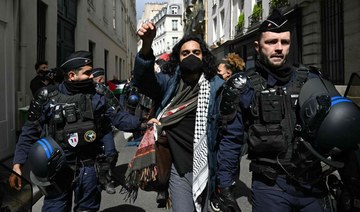VENICE, Italy: Chloe Zhao’s “Nomadland,” a recession-era road trip drama starring Frances McDormand, won the Golden Lion for best film Saturday at a slimmed-down Venice Film Festival, which was held against the backdrop of the coronavirus pandemic.
Zhao and McDormand appeared by video from the United States to accept the award, given virus-related travel restrictions made reaching the Lido in the Italian lagoon city difficult if not impossible for many Hollywood filmmakers and actors.
“Thank you so much for letting us come to your festival in this weird, weird world and way!” McDormand told the masked audience as the Italian marketing team for the film actually accepted the award. “But we’re really glad you let us come! And we’ll see you down the road!”
A favorite going into the awards season, “Nomadland” is screening at all the major fall film festivals in a pandemic-forged alliance involving the Venice, Toronto, New York and Telluride festivals.
Britain’s Vanessa Kirby won best lead actress for “Pieces of a Woman,” a harrowing drama about the emotional fallout on a couple after their baby dies during a home birth. Italy’s Pierfrancesco Fabino won best lead actor for “Padrenostro,” (Our Father), an Italian coming-of-age story that takes place after a terrorist attack in the 1970s.
“It’s the greatest honor of my life,” Kirby said afterwards from the red carpet, admitting that her knees were still shaking. “Cinema is everything to me, and so the fact that we’re all together, everybody, to support it and honor it is all I can ask for.”
Japanese director Kiyoshi Kurosawa won the Silver Lion for best director for “Wife of a Spy,” while the Silver Lion grand jury prize went to Mexico’s Michel Franco for his dystopian drama “Nuevo Orden.”
The Russian film “Dear Comrades!” about a 1960s era massacre in the former Soviet Union, won a special jury prize while Chaitanya Tamhane won best screenplay for “The Disciple,” about an Indian man’s pursuit to be a classical vocalist.
That the 10-day Venice festival took place at all was something of a miracle, given that northern Italy in late February became ground zero for Europe’s coronavivrus outbreak. The Cannes Film Festival was canceled and other big international festivals in Toronto and New York opted to go mostly online.
But after Italy managed to tame its infections with a strict 10-week lockdown, Venice decided to go ahead, albeit under safety protocols that would have previously been unthinkable for a festival that has prided itself on spectacular visuals and glamorous clientele.
Face masks were required indoors and out. Reservations for all were required in advance, with theater capacity set at less than half. The public was barred from the red carpet and paparazzi, who would normally chase after stars in rented boats, were given socially distanced positions on land.
While it’s too soon to say if the measures worked, there were no immediate reports of infections among festival-goers and compliance with mask mandates and social distancing appeared to be high.
“We were a little bit worried at the beginning, of course,” said festival director Alberto Barbera. “We knew that we had a very strict plan of safety measures and we were pretty sure about that, but you never know.”
Hong Kong director Ann Hui almost didn’t make it after she couldn’t get on her flight because of virus border restrictions. In the end, she arrived to collect her Golden Lion Lifetime Achievement Award and to see her out-of-competition film “Love After Love” make its world premiere.
Movie lovers applauded Venice’s effort and the symbolic significance of the world’s oldest film festival charting the path forward.
“It’s a moment of rebirth for everyone, for the whole world,” said Emma Dante, the Italian director of the in-competition film “The Macaluso Sisters.” “This festival is really an important moment of encounter, of beginning to dream again and be together again, even with the norms and following all the safety protocols.”
Film writer Emma Jones said aside from “a few teething problems” with the online reservation system, the festival went off better than she expected.
“It feels safe in there, it feels socially distanced,” she said of the venues.
Jones noted that the lineup of films lacked the usual Hollywood blockbusters — think “La La Land,” and “The Shape of Water” — that have used Venice as a springboard to Oscar fame. While the festival featured films from Iran, India, Australia and beyond, it was heavily European.
“This is a COVID festival. There’s no use pretending anything else,” Jones said.
But she added: “It would feel really off-note, I think, to have had a red carpet with screaming fans and celebrities walking down it and people talking about who wore what. Twenty-twenty is not the year for those kind of discussions.”
Instead, she said, Venice focused on the integrity of the films and the diversity of the countries represented.
“We were lucky to receive a lot of submissions from all over the world, and apart from a few missing titles from the Hollywood major film studios, most of the countries are represented in Venice and the quality of the lineup is really very high,” said festival director Barbera.
Chloe Zhao’s ‘Nomadland’ wins top prize at Venice Film Fest
https://arab.news/23mdg
Chloe Zhao’s ‘Nomadland’ wins top prize at Venice Film Fest
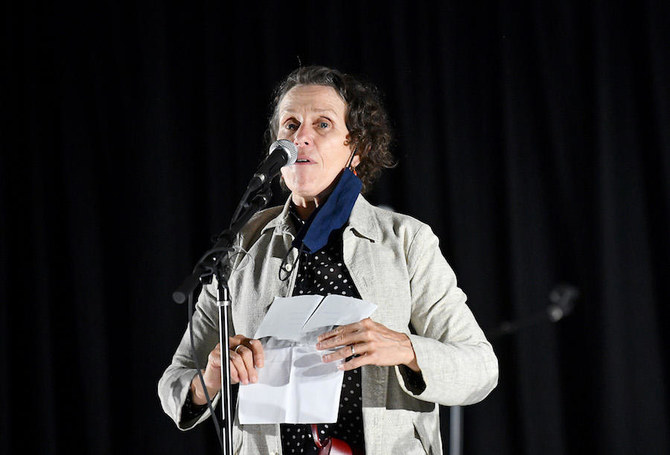
- Zhao and McDormand appeared by video from the United States to accept the award
- A favorite going into the awards season, “Nomadland” is screening at all the major fall film festivals in a pandemic-forged alliance involving the Venice, Toronto, New York and Telluride festivals
Moroccan photographer Hassan Hajjaj captures the culture of AlUla

- The acclaimed Moroccan photographer discusses his recent show in Saudi Arabia
DUBAI: Early in February this year, Moroccan contemporary artist and photographer Hassan Hajjaj was given a reminder of just how high his star has risen. Within a few days of each other, Hajjaj had shows opening in the US, Morocco, and — as part of AlUla Arts Festival — Saudi Arabia.
Hajjaj’s playful portraiture, which incorporates vivid color, funky clothing (almost all of which he designs himself), geometric patterns, and — often — vintage brands from the MENA region, has made him internationally popular, and his instantly recognizable style has established him as one of the world’s leading photographers.
His show in AlUla consisted of images that he shot in the ancient oasis town in February 2023. That visit was initially supposed to involve shoots with around 20 local people. It’s the kind of thing he’s done a few times before, including in Oman and Abu Dhabi. “It’s always a good opportunity to get to know the culture and the people,” Hajjaj tells Arab News.
But, as he says himself, he arrived in AlUla as “an outsider,” so needed a team on the ground to persuade locals to come and sit (or stand, in most cases) for him.
“It was a bit tough, in the beginning, for them to find people,” Hajjaj explains. “But because it was during a period when lots of art things were happening in AlUla, there were lots of people coming from outside AlUla as well. So we opened it up. I basically said, ‘Just come.’
“In the end lots of people turned up, not just locals — people from Riyadh, Jeddah, and people (from overseas) too. I think I shot around 100 people over a few days. So it was a great opportunity,” he continues. “To get to shoot that many people over three days — organizing something like that for myself might take a year. So, as long as I have the energy, when I get these opportunities — you know, I’m in AlUla with this eclectic bunch of people — I’d rather go and grind it, really work hard, and have that moment.”
A Hassan Hajjaj shoot isn’t your regular portrait shoot, of course. “It’s almost like a performance,” he says. “There’s music, people dress up, it’s like a day out for them, taking them out of themselves for a few hours.”
He followed the same modus operandi in AlUla. “We got an ambience going. It was fun, there was music… I shot in this beautiful old school that was one of the first girls’ schools in Saudi Arabia, from the Sixties. Upstairs was like a museum — everything was like a standstill from the Seventies and Eighties; even the blackboards had the chalk and the writing from that time,” he says.

A crucial part of Hajjaj’s practice is to ensure that his subjects are at ease and feel some connection with him (“comfortable” is a word he uses several times when talking about his shoots). While all his portraits bear his clearly defined style, it’s important to him that they should also show something unique to the people in them.
“It’s that old thing about capturing the spirit of the person in that split second, you know? I’m trying to get their personality and body language in the image,” he says. “Quite often I’m shooting in the street, outdoors, so (the subjects) can start looking at other people, thinking, ‘Are they looking at me?’ So I usually say, ‘Listen. This is a stage I’m building for you. I’m dressing you up, and we’re going to have fun.’ Then I just try and find that personality that can come out and make the image stronger. With some people, though, saying almost nothing can be better — just getting on with it. I try to kind of go invisible so it’s the camera, not the person, that’s doing the work. The best pictures come out when there’s some kind of comfortable moment between me and the person and the camera.”
It’s the way he’s worked since the beginning — a process that developed organically, as most of his early portraits were of “friends or friends of friends.”

“There’s a comfort in that because you have a relationship with them. It made it easy,” he says. “And that taught me about how important it is to build trust with people to get into that comfortable zone. But as time went on, obviously, people could see the stuff in the press or on social media, so then people started, like, asking to be shot in that manner; maybe they’ve studied the poses of certain people and stuff like that, so they come ready to do some pose they’ve seen in my pictures. That’s quite funny.”
The work that was on display over the past two months in Hajjaj’s “AlUla 1445” is a perfect example of what he tries to achieve with his shoots. The images are vibrant, playful, and soulful, and the subjects run from a local goatherder through the AlUla football team to bona fide superstars: the US singer-songwriter Alicia Keys and her husband Swizz Beatz.
Hajjaj says he has a number of favorites “for different reasons,” including the goatherder.

“He brought in two goats and it became quite abstract when you put all of them together. I was playing with that notion of the person; you could see that’s his life and even the goats look happy,” he explains. “I wanted to make sure they had that shine in the image as well. I got some great shots of him.”
The Alicia Keys and Swizz Beatz shoot has been a long time in the making. Hajjaj first met Swizz Beatz a decade ago, and they have been in touch intermittently ever since. The idea of a shoot with Keys first came up about five years ago, but logistics had always got in the way. But since they were playing a concert in AlUla at the same time as Hajjaj was there, it finally happened, on Hajjaj’s last day, with perhaps an hour left before the light faded.
I ask Hajjaj if his approach to shooting celebrities differs from his shots of “ordinary” people.

“There’s probably not that much difference,” he says. “They’re coming into my world, so, again, it’s just making sure they’re comfortable with you and you’re comfortable with them; not looking at them (as celebrities). The only thing is you have to imagine they’ve been shot thousands of times — by top photographers, too — so they’re going to have their ways. So I just have to lock in with them and find that comfortable space between the sitter and me.”
And then there’s Ghadi Al-Sharif.
“It’s a beautiful picture. She’s got this smile, with her hand over her face. For me, that one really presents the light and the energy of AlUla,” Hajjaj says. “It captures the new generation.”
Jessica Seinfeld donates to pro-Israel counter-protests

- Wife of Jerry Seinfeld backs pro-Tel Aviv campaign at UCLA
- Palestine supporters were attacked on the campus Tuesday
DUBAI: American cookbook author Jessica Seinfeld, the wife of comedian Jerry Seinfeld, is backing a pro-Israel counter-protest at the University of California, Los Angeles.
This initiative comes in response to Tuesday night’s outbreak of violence when a group of people assaulted pro-Palestine protestors in their encampment on campus.
Seinfeld highlighted a GoFundMe campaign on her Instagram page and contributed $5,000.
The majority of donations to the fundraiser have been made anonymously. As of Wednesday, the page had accumulated over $93,000.
Seinfeld explained to her Instagram followers that she had donated to the GoFundMe page to “support more rallies” like the ones at UCLA. Encouraging others to do the same, she wrote: “More cities are being planned so please give what you can.”
Billionaire hedge fund manager Bill Ackman, who has previously spoken out about alleged antisemitism at Harvard, contributed $10,000 to a GoFundMe campaign initiated by Nathan Mo from Beverly Hills.
Muslim organizations and students at UCLA have denounced university officials and law enforcement, alleging that they had failed to intervene as students within the pro-Palestinian encampment faced verbal harassment, pepper spray and physical assault.
Ithra showcases Arab creatives at Milan Design Week

- The Dhahran-based cultural center took part in the prestigious Italian fair last month
DUBAI: The King Abdulaziz Center for World Culture (Ithra) participated in Milan Design Week between Apr. 16 and 21. It was the second time Ithra has taken part in the annual event — a significant entry in Italy’s cultural calendar.
Ithra was founded with the goal of developing Saudi creative talent. Noura Alzamil, the center’s head of programs, has seen its influence mushroom since the beginning and continues to be in awe of her country’s rapidly developing art scene.
“Practicing it and seeing it every day around you and reading about it in articles and seeing that interaction and conversation on a national level, is really heartwarming,” she says.

“We’ve been active for the past 13 years, in collaboration with the Ministry of Culture, doing a lot of enriching programs, activations, bringing in new content and experimenting with our community and exposing them to arts, museums theatre, films,” Alzamil adds. “To me, investing in Saudi minds helps them excel in the future. I believe heavily in taking care of young talents, supporting professionals and having a global conversation.”
Ithra also houses what it bills as the region’s first ‘Material Library,’ displaying a variety of raw design materials. “Artists are all about experimentation,” Alzamil says. “The Material Library hosts hundreds of different materials that designers can come and play with.”
A cornerstone of Ithra’s programming is Tanween, a four-day conference that showcases creative designs from university students and emerging creatives from the region. The products from the conference are then exhibited in public events, such as Milan Design Week.

“To me, and to Ithra, it’s really important to showcase our efforts and Saudi and Arab designers in such festivals. Being presented among our peers there is something that we really care about,” says Alzamil. This year, Ithra presented an exhibition of items created by MENA artists in a wide range of mediums in Milan — the first time the center has presented a full show there.
Entitled “From Routes to Roots” and presented in collaboration with Isola (a Milan-based digital platform), the show included glasswork, clay, rugs and lighting. One of the key ideas of the exhibition was to demonstrate how creatives are preserving heritage and the Earth through circular design, which helps to eliminate waste from production.
“They used a lot of integrating bio materials, natural resources, household and industrial waste to come up with these innovative designs and objects that showcase and support sustainability,” Alzamil says.

Participating creatives hailing from the Levant, North Africa and the Gulf included Marwa Samy Studio, Ornamental by Lameice, Joe Bou Abboud, T Sakhi Studio, Bachir Mohamad, Studio Bazazo, and Mina Abouzahra.
“The exhibition draws inspiration and expertise from ancestral culture pairing it with cutting-edge craftsmanship, in a demonstration of how emerging talents can breathe fresh life into the design landscape, bridging the gap between tradition and innovation,” according to a press release.
Lebanese designer Bou Abboud presented a triad of round lighting fixtures that he says pay tribute to old Qatari jewelry, particularly long necklaces.
One of the more delicate pieces on view came courtesy of Jerusalem-based Palestinian designer Lameice Abu Aker. Her light-toned vases, jugs and drinking glasses are fluid and bubbly. She showcased a molecular-looking, violet vase called “Chemistry!” On Instagram, Abu Aker’s brand posted that the piece is “the perfect fusion of art and science, crafted with precision and care by our skilled artisans. Mouth-blown, every curve and line reflects the magic of the chemical reactions that inspired its name.”
Hanging textiles were also noticeably dominant in Ithra’s display. For instance, Doha-based artists Bachir Mohamad and Ahmad Al-Emadi collaborated on geometrical, symbol-heavy, blue-and-white rugs that are an homage to traditional Gulf Sadu weaving, historically practiced by Bedouins.
“It was really exciting,” Alzamil says of the show. “The team received a lot of visitors and different players in the field. . . It’s bridging the gaps between Saudi and international communities.”
London’s Arab Film Club launches podcast focusing on Palestine

DUBAI: The Arab Film Club, a monthly gathering in London celebrating Arab cinema, launched a podcast on May 1.
Spearheaded by the club’s founder, Sarah Agha, an Irish Palestinian actress and writer, the inaugural five-episode season of the interview-based podcast will focus on Palestinian filmmakers and cinema’s role in cultural resistance.
The debut episode features Darin J. Sallam, director of “Farha,” Jordan’s Oscars entry in 2022. In other episodes, Agha interviews Lina Soualem, (“Bye Bye Tiberias”), Ameen Nayfeh (“200 Metres”) Annemarie Jacir (“Wajib”) and Farah Nabulsi (“The Teacher”).

Agha told Arab News, “It is so urgent right now to do anything and everything we can to keep talking about Palestine. So I thought, ‘Why not do some interviews with some of my favorite Palestinian directors and put them online so everyone can listen to them?”
Reflecting on Sallam’s episode, Agha highlighted the transformative potential of cinema. “She is linking educational talks with her film, and I do believe her film is like a tool of change,” the presenter said.
Agha said she found Soualem’s documentary particularly intriguing, due to its departure from the scripted films typically showcased at the Arab Film Club.

“I wanted to make an exception for Soualem’s film because it’s another portrayal of the Nakba, but in very different terrains — like, totally different,” she explained. “My father is from Tiberias, so I was also attracted to it for that reason.”
Agha believes her podcast is launching at a time when Palestinians are being censored in the arts.

“There’s been a lot of cancellations of events to do with Palestine and Palestinian narratives,” she said. “So I think the best thing that we can do is not succumb to hopelessness. The fact that they’re trying to silence voices means those voices are significant. You don’t silence something that’s irrelevant. For example, the fact that the Israeli government tried to pressure Netflix into removing Darin’s film shows that it’s important.”
Agha hopes the podcast will appeal to a diverse audience, including non-Arabs.
“That, for me, is a really big thing. If we just talk to ourselves all the time, we won’t really get any further with reaching a wider audience,” she said.
The Weeknd donates $2 million for humanitarian aid in Gaza
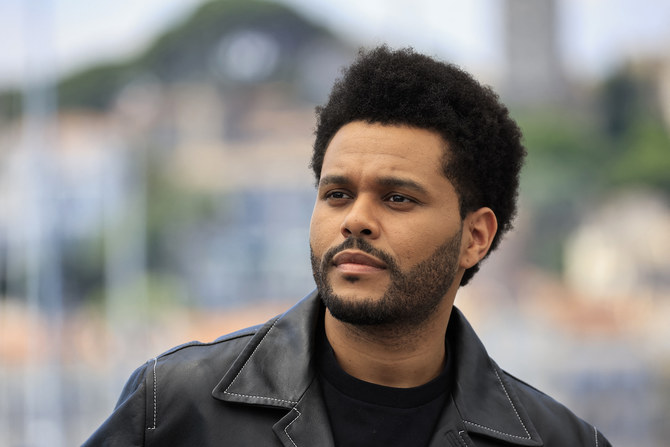
DUBAI: Canadian singer The Weeknd has pledged to donate another $2 million to help feed families in Gaza, the United Nations’s World Food Programme reported.
The donation comes from the star’s XO Humanitarian Fund, which helps combat global hunger.
“This support will provide over 1,500 metric tons of fortified wheat flour, which can make over 18 million loaves of bread that can help feed more than 157,000 Palestinians for one month,” said WFP.
In December, the multi-platinum global recording artist, whose given name is Abel Tesfaye, donated $2.5 million to WFP from the fund, which he established in partnership with World Food Program USA. That equated to 4 million emergency meals, funding 820 tons of food parcels that could feed more than 173,000 Palestinians for two weeks.
Tesfaye, who was appointed a Goodwill Ambassador in October 2021, is an active supporter of WFP’s global hunger-relief mission. He, his partners and his fans have raised $6.5 million to date for the XO fund.
In total he has directed $4.5 million toward operations in Gaza and has sent $2 million to support WFP’s emergency food assistance for women and children in Ethiopia.


